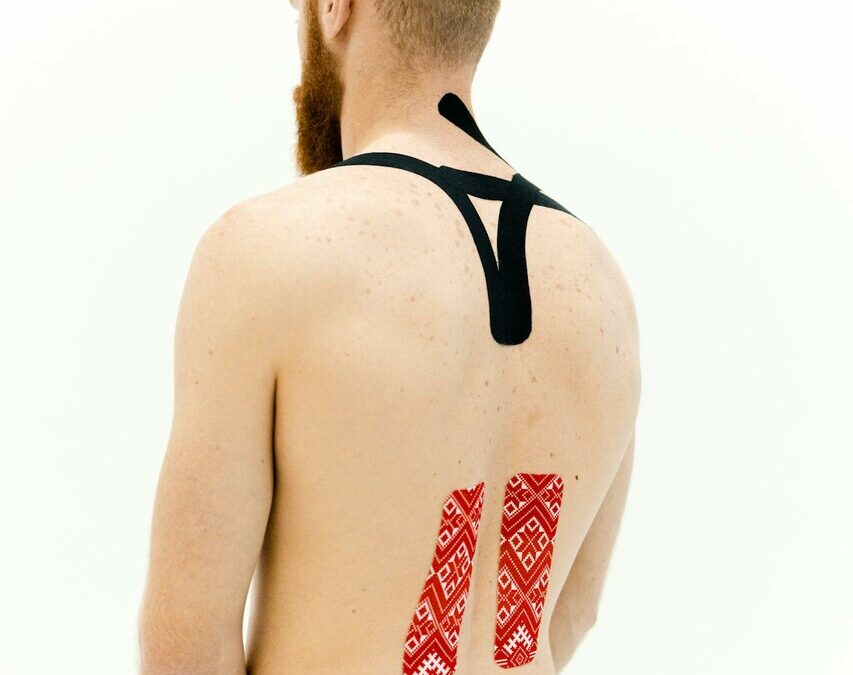If persistent low back pain is limiting your daily activities, Kinseo tape can provide relief. Kinesio tape offers an effective, non-invasive approach to managing low back pain. In this article, Augusta Acupuncture Clinic is going to discuss the benefits of Kinesio tape for back pain, its limitations, and how acupuncture treatments provide better long-term relief by addressing both the symptoms and root causes of low back pain.
How Kinesio Tape Provides Short-Term Relief
When correctly applied to the skin, Kinesio tape provides a gentle lifting that improves circulation and reduces pressure on pain receptors. This specialized elastic tape mimics skin elasticity while providing structural support to muscles and fascia in the lumbar region.
Is it effective? Several studies have shown that Kinesio tape can help patients with acute back pain episodes by:
- Reducing pressure on inflamed tissues by microscopically lifting the skin
- Creating sensory feedback to improve movement awareness
- Supporting overworked muscles without restricting natural movement
- Decreasing swelling by enhancing lymphatic drainage
- Providing psychological reassurance through physical support
Proper Application Techniques for Back Pain
Proper application is necessary for achieving the best results when using Kinesio tape for low back pain:
I-Strip Method: Apply vertical strips on either side of the spine with 10-25% stretch. These parallel strips provide direct support to the paraspinal muscles most affected by chronic tension patterns.
Fan Technique For diffuse pain covering broader areas, apply tape in a fan pattern starting from a common anchor point. This approach helps distribute forces more evenly across affected tissues.
Lumbar Support Method: Apply horizontal strips across the lower back while maintaining neutral spine positioning. This technique provides stability during movement without restricting flexibility.
Understanding Kinesio Tape Limitations
While Kinesio tape for low back pain delivers valuable temporary relief, we must acknowledge its limitations. Tape applications typically remain effective for 3-5 days before losing elasticity and adhesion. More importantly, once removed, pain often returns because the underlying dysfunction remains unaddressed.
Kinesio tape primarily addresses surface symptoms rather than root causes, such as:
- Biomechanical imbalances affecting spinal alignment
- Deep tissue restrictions limiting normal movement patterns
- Pain signals perpetuated by nervous system sensitization
- Muscular weakness in core stabilization systems
- Fascial adhesions restricting natural tissue glide
Why Pain Returns After Taping
Many patients experience recurring discomfort following initial improvement with Kinesio tape for low back pain. This pattern occurs because taping provides external support without resolving internal dysfunction.
When external support disappears, compromised tissues must again manage forces independently, often failing to maintain proper alignment and movement patterns. This temporary improvement, followed by recurrence, creates frustrating cycles of relief and relapse for chronic pain sufferers.
Complementary Approaches for Lasting Results
Combining Kinesio tape with evidence-based treatments creates more comprehensive pain management strategies:
Core Strengthening: Develop targeted exercise programs addressing specific weakness patterns contributing to spinal instability. Progressive resistance training builds lasting internal support structures.
Movement Retraining: Learn proper movement mechanics, reducing stress on compromised tissues. Simple adjustments in daily activities often prevent recurring strain patterns.
Manual Therapy Professional hands-on techniques address deeper restrictions that taping cannot reach. These treatments restore normal tissue mobility essential for pain-free movement.
Acupuncture: Addressing Root Causes of Back Pain
Unlike Kinesio tape, acupuncture addresses both symptoms and underlying causes. This comprehensive approach helps explain why patients experience lasting improvements rather than temporary relief.
Acupuncture stimulates specific physiological mechanisms promoting genuine healing:
Nervous System Regulation Pain perception often involves heightened nervous system sensitivity. Acupuncture normalizes these responses, reducing inappropriate pain signaling even after treatment ends.
Fascial Release Precision needle placement releases deep connective tissue restrictions that external taping cannot influence. This internal release restores normal tissue relationships essential for pain-free movement.
Trigger Point Deactivation Acupuncture directly addresses hypersensitive muscle tissues, perpetuating pain cycles. Targeted treatments reset muscle tone and function without requiring external support.
Integrating Kinesio Tape with Acupuncture
At Augusta Acupuncture Clinic, we sometimes recommend Kinesio tape for low back pain as a supportive measure between acupuncture sessions. This integrated approach allows patients to:
- Maintain the improvements gained during acupuncture treatments
- Reinforce proper movement patterns during daily activities
- Experience continued sensory feedback supporting posture awareness
- Manage flare-ups during intensive treatment phases
- Gradually reduce dependence on external support as internal function improves
Personalized Treatment Planning
Our practitioners develop individualized approaches addressing your specific pain patterns and contributing factors. We conduct thorough assessments identifying:
- Movement restrictions affecting spinal mechanics
- Muscle imbalances contributing to poor posture
- Structural misalignments create abnormal stress patterns
- Lifestyle factors perpetuating pain cycles
- Previous treatment responses guiding current strategy development
Patient Success Stories
Many patients arrive at our clinic having tried Kinesio tape for low back pain with initial success but frustrating recurrences. They discover meaningful differences with our comprehensive approach combining acupuncture with supportive techniques.
“After months of taping my back every week, I realized I was just managing symptoms without addressing why my pain kept returning. Six acupuncture sessions accomplished more lasting improvement than a year of taping alone.” — Michael R., Augusta
Creating Your Recovery Strategy
Moving beyond temporary fixes requires a strategic approach. This includes:
Assessment Phase: Begin with a professional evaluation identifying specific dysfunction patterns contributing to your pain. This foundation helps properly target treatments.
Treatment Implementation: Address root causes through acupuncture using Kinesio tape as supportive therapy during early recovery.
Progressive Independence: Gradually reduce reliance on external supports as internal function improves through targeted treatments and appropriate exercise.
At Augusta Acupuncture Clinic, we understand the benefits and limitations of Kinesio tape for low back pain. Our practitioners combine traditional acupuncture wisdom with modern sports medicine approaches to help you achieve lasting relief, not just temporary symptom management.
Call Augusta Acupuncture Clinic at (706) 888-0707 or visit us at 4141 Columbia Rd Suite B, Augusta, GA 30907. Let us help you develop a comprehensive plan addressing the root causes of your back pain for genuine, lasting improvement.

